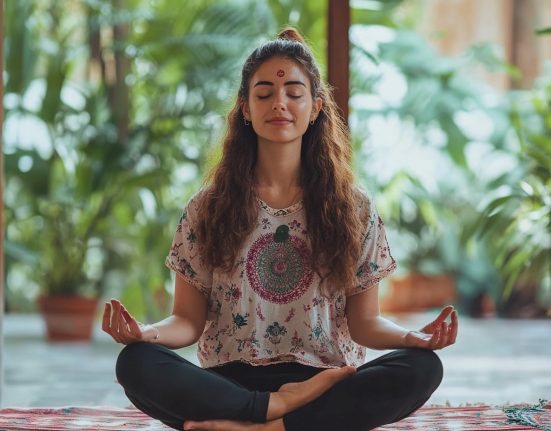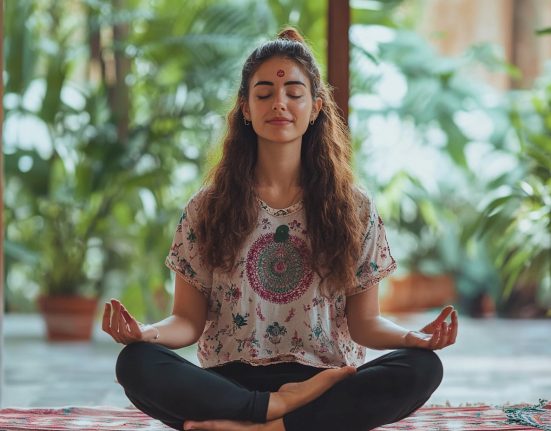Meditation can seem impossible for beginners, but it’s all about having the right attitude.
You’ve probably heard of the numerous benefits of meditation, from alleviating anxiety, depression and pain, to helping relieve insomnia. The practice has been around since ancient times, and is now popular even with those who are less spiritually inclined, thanks to classes and apps like Calm.
But if you’re unfamiliar with it, when it comes to getting started on meditation, it can feel downright intimidating. For some, the thought of sitting still for an extended amount of time is overwhelming. For others, they would love to sit in silence for a while, but kids, pets or other obligations seem to keep them from finding the time.
Whether you’re curious about meditation or a longtime meditator looking to get back into the practice, the tips below can help you start or restart meditating. Ashley Wray, meditation teacher and founder of Mala Collective, shares her best tips for beginning meditators below.
Myths about meditation
One of the hardest things about meditating is simply starting. There’s a lot of information about meditation out there, and much of the information says that there’s a right and wrong way to do it.
But according to Wray, these types of preconceived notions prevent most people from starting or keeping a practice because they’re too intimidated. Below, she dispels common myths that can hold you back on your meditation journey.
Myth 1: There is a ‘right’ way to meditate
With all of the meditation courses, apps, and books out there, you’re probably thinking that there’s a right or wrong way to meditate. There are many different styles and philosophies surrounding mindfulness and meditation practices, the best one for you is the one that you’ll actually want to do.
“Try not to get too caught up on the form — if you’re doing it right or wrong… and just do it. Build the habit first instead of worrying if you’re sitting correctly or doing it right,” Wray says.
Myth 2: You’re not allowed to think
One of the most common misconceptions about meditation is that if you allow yourself to think while meditating, then you’ve failed. But Wray says that’s simply not the point.
It’s normal for your mind to wander while you meditate, but the important thing is to notice it and not let it derail you. “Even if it’s uncomfortable, just watch your thoughts and come back to your focus. And when your mind wanders, you can choose to judge yourself or come back with kindness,” says Wray.
Myth 3: You have to meditate for 30 minutes or longer
Another common myth around meditation is that you have to do it for a certain amount of time for it to “work.” Some people talk about meditating for 30 or 45 minutes or even for hours — which is super intimidating when you’ve never even meditated for 5 minutes.
“Thinking you need to clear your mind for 20 minutes or 30 minutes is a really intimidating approach to meditation. So I try to make it a bit more accessible with this idea that maybe it’s 10 minutes or 8 minutes to connect to your breath and slow down and find some space in between your thoughts,” Wray says.
Beginner tips for meditation
Wray teaches new meditators frequently, and says that most people don’t even start meditating because they “have an all-or-nothing approach.”
Again, there’s no one right way to meditate. Try the tips from Wray below to help guide you with your new meditation practice.
Have something to focus on
When you first start meditating it can feel really uncomfortable to sit in silence without distractions, like your phone, around. One minute can feel like hours.
For this reason, Wray suggests using a tool to help you focus on your meditation, especially when your mind wanders. She suggests mala beads — prayer beads that some people use to meditate — for beginners because it gives you something tactile to focus on.
“The mala beads have helped me to not look at my phone as much [and ignore other distractions]. It’s just an easy focal point that is good for beginners to help with both the energy and attention and the timing,” she says.
Use and app or guided meditation if you’d like
Using a meditation app or guided meditation video can be helpful when you first start. While these tools aren’t necessary, they can give you an idea of what different meditation styles are like or help give you some structure around how to meditate.
Many of the apps offer meditation challenges, which can be helpful for getting in the habit. Popular apps include Headspace, Calm and Insight Timer.
Don’t beat yourself up if you get distracted or can’t stay consistent
Meditation is not about being perfect, it’s about showing up and trying, no matter what that looks like for you. “Be easy on yourself and be kind to yourself. It really isn’t an all or nothing. If you miss a couple days, that’s fine. I have days where I feel like I don’t want to be doing this, and I have other days where it’s the most groundbreaking thing,” says Wray.
Tie meditation to a ritual you already do
All of us have routines and rituals that are ingrained throughout our days. Whether it’s making coffee or making your bed, tying your meditation to a routine you already have can make it easier to remember and more likely that you’ll actually do it. For example, you can meditate while your coffee is brewing. That can mean as soon as it starts, you sit down to meditate, even if it’s only for 5 minutes.
Designate a space in your home to meditation
Setting up a physical space in your home to meditate, even if it’s just the corner beside your bed, can help make you more likely to take the time to do it. Seeing a special meditation cushion or pillow that you like can be a simple reminder to meditate. You can add personal touches like a candle or something else relaxing that makes the place a restful place you look forward to going to each day.









